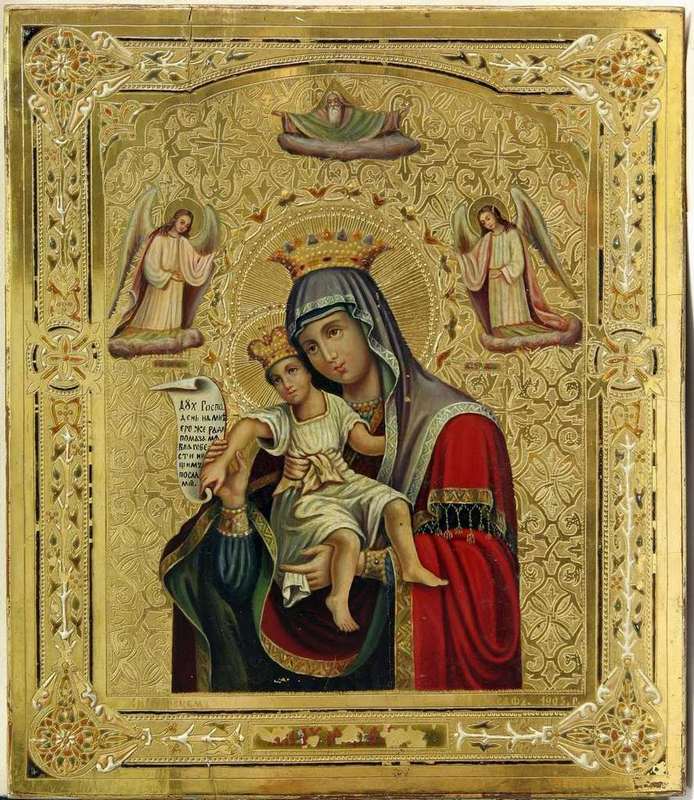  #Exhibit of the Month #Exhibit of the Month
May 2025
The Mother of God “It Is Truly Meet”
(“Axion Estin”)

The history of this icon traces back to the 10th century at the Protaton Monastery on Mount Athos. In one of the cells named "The Dormition of the Mother of God," an elderly hieromonk lived with his disciple. They preserved a superb depiction of the Virgin Mary. This old icon became renowned through the revelation of the prayer "It Is Truly Meet."
Between the years 980-982, on a Saturday evening before an all-night vigil, the elder monk left for the nearby church, instructing his disciple to continue the religious routine in the cell. Being obedient, the disciple followed the instructions. When he reached the 9th Ode of the Canons, "More Honorable Than the Cherubim...," he suddenly heard someone beginning to chant alongside him: "It is truly meet to bless thee, O Theotokos..." It was a mysterious pilgrim monk who had appeared unexpectedly and joined in the prayers. At that moment, the icon began to radiate light, as if it were broad daylight. Astonished by the events, the disciple asked the mysterious monk to write down the verses. The monk wrote them on a tile with his finger as if it were soft wax and said, "From now on, this is how you Orthodox Christians should chant," and, saying this, he vanished. Left alone, the disciple realized he had witnessed a great miracle. Enlightened, he understood that the pilgrim was none other than the Archangel Gabriel, who had come, as he had before, to deliver the word of the Highest to humanity.The icon was transferred from the cell to the Holy Altar of the Protaton Church, where a similar icon is preserved to this day. The tile with the divine hymn was taken to Constantinople and included in the Orthodox Church's liturgical books. Soon after, Archangel Gabriel's prayer was incorporated into the Divine Liturgy, immediately following the Consecration of the Gifts of Bread and Wine. The valley with the cells has since been called Adin, meaning "to chant," "chanting." The icon "It Is Truly Meet" is of inestimable value and has become the protector of Mount Athos. The icon is celebrated on June 11/24, commemorating the miraculous appearance of the Archangel, and on July 13/26, in honor of the Synaxis of the Archangel Gabriel. This icon, of the Eleusa type, portrays gentleness and tenderness in its central figures. The Virgin holds the Child with her right hand, while her left hand, placed beneath His feet, grips the hem of His tunic. The small Jesus wears a short tunic reaching His knees and holds a scroll in His right hand inscribed with the words of the Axion hymn. His left-hand slips under the veil of the Virgin towards her left shoulder. Both figures are crowned with golden halos. Two angels flank the Virgin's halo, while the Almighty in an open heaven blesses with both hands. Crafted using tempera on wood, the icon is adorned with gold leaf and multicolored enamel, giving the image a unique delicacy. The inscription on the lower frame indicates that the icon was created by the painter Ioasaf in 1905. The painter monk Ioasaf Berghie (1862-?) of the New Neamț Monastery resided there between 1887 and the 1940s, occupying three rooms to set up his studio, where he worked continuously on icons and church artworks. Born into the family of a church teacher in Jabca village, Ștefan Berghie, Ioan Berghie developed a passion for sacred iconography from an early age. In 1890, Andronic, the abbot of the New Neamț Monastery, blessed him to paint icons. Taking monastic vows in 1895 under the name Ioasaf, he traveled by foot to visit major ecclesiastical centers nearby and further afield, learning the art of iconography. Starting with naive-style interpretations, he eventually mastered professional painting techniques and acquired new decorative skills. His works became highly popular throughout Bessarabia and abroad. Painting a significant number of icons, they were often mistakenly sold as coming from major artisan workshops. To prevent such confusion, he received the abbot's blessing to sign his works, earning recognition and fame for his name.
|



















































